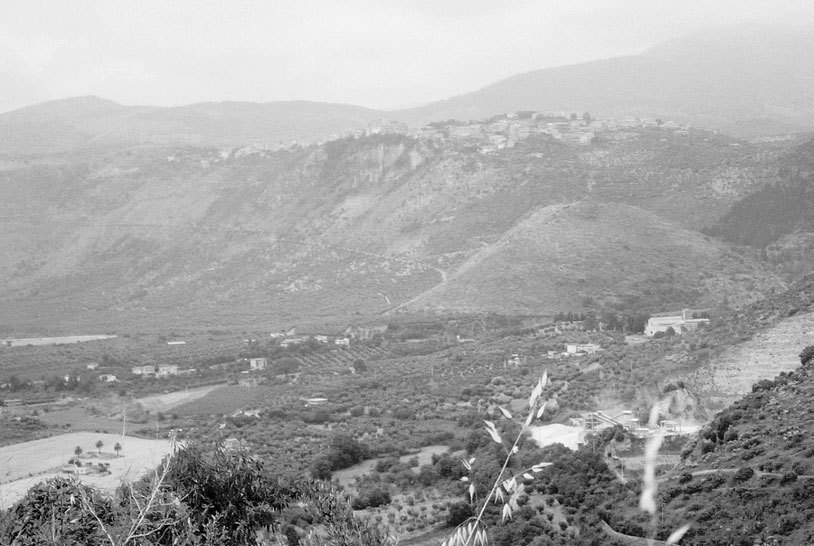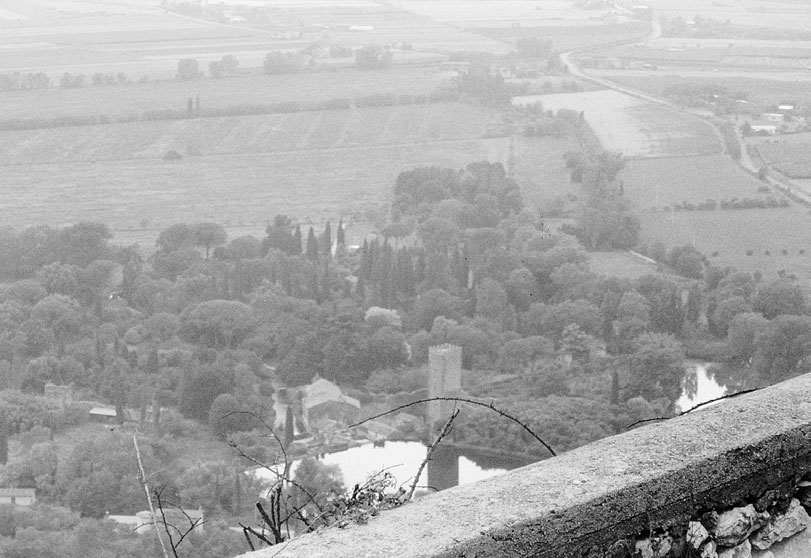Malaria and Rome: A History of Malaria in Ancient Italy (13 page)
Read Malaria and Rome: A History of Malaria in Ancient Italy Online
Authors: Robert Sallares
Tags: #ISBN-13: 9780199248506, #Oxford University Press, #USA, #History

56
Ecology of malaria
7. Plan of modern Sezze (ancient Setia).
Ecology of malaria
57
river valleys in the early modern period. For example, the Tiber was affected for a large part of its course, as were many other rivers in Lazio such as the Aniene, Arrone, Galera, Marta, Sacco and Timone. Tibullus’ recommendation, quoted above, that the vicinity of rivers and streams in Etruria should be avoided in the summer, should be recalled. It suggests that river valleys were as unhealthy in the first century as in the early modern period.
Varro and Vitruvius also recommended building a villa on elevated ground, not in a hollow.³² This was a frequent and again well-founded recommendation in antiquity, since mosquitoes, which are weak fliers, dislike flying upwards and dislike windy locations.
Antyllus, writing in the second century , summarized the prevailing view in antiquity as follows: Localities situated at high altitude are the healthiest places, since the air is not static, but is scattered around and continuously driven away by the winds. Airy places are suitable for all afflictions of the chest and head and all the faculties.³³
Procopius stated that the air on Mt. Vesuvius was very light and extremely healthy. Consequently patients with tuberculosis were sent there to recuperate.³⁴ At least such patients would have avoided the synergistic interactions of tuberculosis with malaria (see Ch. 5. 2 below). Celli noted that the town of Norma, situated on a hill 433 metres above sea level overlooking the Pontine Marshes, was free from malaria in the nineteenth century, while the vicinity of Ninfa (described by Gregorovius as ‘the little medieval Pompeii’), located at the foot of the same hill, was intensely malarious, the cause of its abandonment between 1675 and 1680.³⁵ In husbands, who had all died from malaria, by the time she reached the age of thirty. This was the inverse to the situation described in the English marshlands by Dobson (1997), where men who had been brought up in the marshes married women moving into the marshlands from other areas, who died rapidly. [Aristotle]
Problems
1.21.862a described marshes as unhealthy.
³² Varro,
RR
1.12.3; Vitruvius 1.4.1.
³³ Antyllus per≥ tÎpwn ka≥ t0n ƒn aÛto∏ß åvrwn in Stobaios,
florilegium
101.18, ed.
Wachsmuth and Hense: oÈ Ëyhlo≥ t0n tÎpwn ËgieinÎtatoi, toı åvroß ƒn aÛto∏ß oÛ mvnontoß åll¤ ka≥ periceomvnou ka≥ ËpÏ t*n ånvmwn sunec†ß åpwqoumvnou: eÛpnoo≤ te d¶ ka≥ diaqvs-esi p3saiß ƒpit&deioi ta∏ß per≥ q*raka ka≥ kefal∫ peponqu≤6 ka≥ to∏ß ajsqhthr≤oiß p$sin.
Nutton (2000
b
) discussed the ancient tradition of meteorological medicine.
³⁴ Procopius,
BG
2.4.30, ed. Haury (1905).
³⁵ Celli (1900: 85); Pratesi and Tassi (1977: 140–1) described the area of Ninfa, as did Tomassetti (1910: ii. 393–406, esp. 399–400 for the date of Ninfa’s abandonment). Tomassetti thought that Ninfa was healthy in antiquity, but there is no positive evidence for this.

58
Ecology of malaria
8. View of Norma
in the distance from
Sermoneta. Situated
on top of a hill overlooking the Pontine
plain, modern
Norma and the
ancient Roman
colony of Norba
(450 metres above
sea level), which lies
beyond it, did not
have endemic
malaria, since
mosquitoes are
weak fliers.

9. View of Ninfa
from Norma.
Situated at the foot
of the hill below
Norma, in the
Ecology of malaria
Pontine plain, Ninfa
suffered from intense
malaria as a result of
which the settlement
was eventually completely abandoned
in the seventeenth
century. Today the
ruins of the settlement are part of a
botanical park and
wildlife reserve
administered by the
Fondazione Caetani
and the World
59
Wildlife Fund.
60
Ecology of malaria
general malaria was not found above 500 metres in Italy. Consequently it was not found in the higher parts of the Colli Laziali, Monti Lepini, Monti Simbruini, and Ciociaria in Lazio. In the eighteenth century population growth occurred in these more mountainous areas, while the lowland populations stagnated or declined, and the bulk of the population was concentrated in the more mountainous regions. However, in southern Etruria there are not many localities whose altitude exceeds 500 metres.³⁶ Malaria creates differential demography according to altitude. Nevertheless it is important to bear in mind that people who live at altitude but descend to work will still be vulnerable to infection in their working environment, as we have already seen in relation to Sezze.
North observed that those inhabitants of Rocca Massima, situated at an altitude of over 700 metres, who went to work on the plain below frequently became infected with malaria. In general, upland areas were much healthier than lowland areas in the past in central and northern Europe, as various studies have shown. However, in the more mountainous parts of central Italy, where peasants often lived in housing which was inadequate for the winter, the winter cold could cause some adverse demographic effects. A comparison of Treppio, located 700 metres above sea level, with Casalguidi found that infant mortality in the first year of life was higher in Treppio for that segment of each cohort born during the winter months. To understand the ancient preference for elevated locations, it is essential to remember that it is only when the comparison is with lowland populations affected by endemic malaria that upland regions in central Italy in the past had an overwhelming advantage in terms of health. It is only in comparison with the intense malaria of Grosseto that Treppio appears extremely healthy.³⁷
There is also a famous passage in Varro on the causes of disease in swamps:
Care must also be taken in marshy areas . . . because certain small animals ³⁶ Rendeli (1993: 121–2).
³⁷ Breschi and Livi-Bacci (1986) on Treppio and Casalguidi; on the effects of altitude on malaria in Italy see Bonelli (1966: 678–81); North (1896: 98–105); F. Giordano
Condizioni topografiche e fisiche
in
Monografia
(1881: ix–xvii); Celli (1900: 177); Douglas (1955: 305); Levi (1945: 74). Viazzo (1989: 198, 212, 215–18, 289) described the healthiness of Alpine environments.
Balfour (1935: 329) stated that malaria was commoner below 250 metres above sea level in Greece, while Dobson (1997: 107) observed that the worst affected parishes in England were below 50 metres above sea level, while parishes above 400 metres were very healthy.
Ecology of malaria
61
breed there. These animals cannot be seen with the naked eye and enter the body through the mouth and nostrils in the air and cause severe diseases.³⁸
Varro’s
animalia quaedam minuta
appear to be the invisible particles of disease postulated in the atomic theory of Lucretius, as suggested by Phillips, rather than mosquitoes, or even less likely, the protozoa of malaria. This passage is unparalleled in ancient Latin literature and Varro’s idea had no practical consequences.³⁹ Nevertheless his recommendations are interesting, including the suggestion that unhealthy localities were better worked with hired labour rather than slaves.⁴⁰ This idea is significant for understanding the agricultural economy of the regions of Italy in which malaria was endemic in the past, as will be seen later.
Columella advised against siting farm buildings next to marshes, making a more direct reference to mosquitoes.⁴¹ He also noted that the water of marshes was pestilential, but only in summer, and Vitruvius also observed that the most pestilential places were healthy in winter.⁴² Antyllus and Athenaios both described marshes as pestilential in summer.⁴³ These texts introduce the very important question of the seasonality of malaria, which has recently been studied by Scheidel employing funerary inscriptions and modern ³⁸ Varro,
RR
1.12.2:
Advertendum etiam, siqua erunt loca palustria . . . quod crescunt animalia quaedam minuta, quae non possunt oculi consequi, et per aera intus in corpus per os ac nares perveniunt atque efficiunt difficilis morbos
.
³⁹ Phillips (1982); Nutton (1983: 10–11) discussed Varro and Columella on marshes. He argued that Galen did take the ‘seeds of disease’ theory seriously as an explanation for some time, but eventually subordinated it to the humoral theory, in which a humoral imbalance was required for the ‘seeds of disease’ to have any effect.
⁴⁰ Varro,
RR
1.17.3:
gravia loca utilius esse mercennariis colere quam servis
.
⁴¹ Columella,
RR
1.5.6:
nec paludem quidem vicinam esse oportet aedificiis . . . quod illa caloribus noxium virus eructat et infestis aculeis armata gignit animalia, quae in nos densissimis examinibus involant (And there should not be a marsh close to the buildings . . . because it throws up an evil odour during the summer heat and produces insects armed with dangerous stings, which swoop upon us in dense swarms.).
⁴² Columella,
RR
1.5.3:
deterrima palustris, quae pigro lapsu repit; et pestilens, quae in palude sumper consistit. Hic idem tamen umor, quamvis nocentis naturae, temporibus hiemis edomitus imbribus mitescit (Worst of all is marsh-water, which flows along with slow movements; and water which always remains in a swamp is pestilential. However this same water, although its nature is harmful, is tamed by the winter rains and becomes harmless.); Vitruvius, 1.4.4.
⁴³ Antyllus in Stobaios,
florilegium
101.18: oÈ d† ‰l*deiß kako≥ m†n åe≤, qvrouß d† ka≥
loim*deiß (Marshes are always bad, and pestilential in summer.); Athenaios in Oribasius 9.2.10, ed. Raeder (1926–33): ƒpinoswtvrouß ojÎmeqa toŸß limn3zontaß ka≥ ‰l*deiß tÎpouß, ka≥ m3lista toı qvrouß, di¤ t¶n ånwmal≤an toı åvroß (We reckon that places with stagnant and marshy water are rather unhealthy, particularly in summer, because of the irregularity of the air.).
62
Ecology of malaria
comparative evidence.⁴⁴ In the early eighteenth century Lancisi described the succession of different types of fever in the summer in Lazio, first benign tertian fevers, then continuous fevers, then pernicious fevers at the time of the autumn equinox (especially if there were showers, clouds, and south winds), and finally long-running quartan fevers.⁴⁵ In nineteenth-century Rome there were no new cases of
P. falciparum
malaria from March to June inclusive, because of its temperature requirements for sporogony in the mosquito.
Any cases that developed during those months were recrudescences of previous infections. The annual epidemic broke out in Rome rather suddenly in July each year. The annual maximum number of cases was usually attained in Rome in August (but sometimes as late as October). This explains the significance of the
dog-days
, the period after the heliacal rising of Sirius (the hound of Orion and so the dog-star for the Greeks) in late July, as not only the hottest time of the year but also an extremely unhealthy season.⁴⁶ Theophrastus attempted to explain in climatic terms both the late summer peak of malarial fevers and the peak of gastro-intestinal infections that also occurred in the summer in Mediterranean countries. ‘During the dog days, even though the air is very hot, nevertheless south winds blow and clouds form and trees themselves become visibly fluid and a certain degree of fluidity spreads under the bark, as a result of which there are flows of sap in trees even at this time of the year, either because of the concentration of the fluid owing to reciprocal displacement or because of some other cause. This also happens in humans, and that is why the bowels become very loose at this time and fevers are very frequent, since bodies become fluid.’⁴⁷
Since malaria could take several months to be fatal, direct mortality from cases arising in August could be delayed until the winter.
The timing of the seasonal peak varied from place to place. At ⁴⁴ Scheidel (1996).